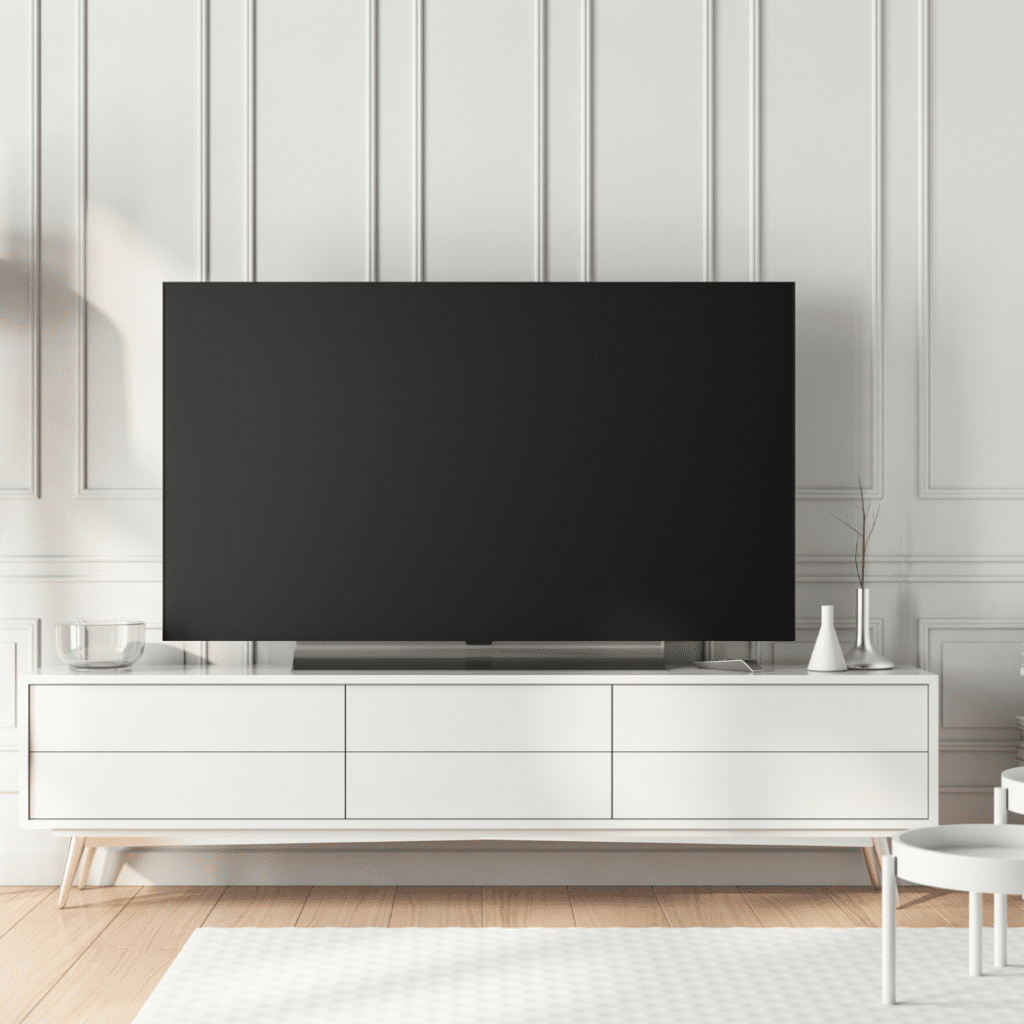The television market has exploded in recent years, with new innovations and technologies being developed all the time. With so many options available, it can be difficult to make a decision about which TV is best for your home audio and video solution. This article will help guide you through the basics of what each type of TV offers, such as LED vs OLED vs QLED, as well as some pros and cons that may help you decide which technology is right for your needs.
LED TVs
LED TVs are the most common type of television available. They use light-emitting diode (LED) backlights to create an image on the screen. This type of TV is typically less expensive than OLED or QLED TVs, and they offer good picture quality. However, because LED TVs use a backlight, they can sometimes produce glare or reflections that can be distracting.
Pros:
- Saves electricity. An LED TV, unlike an LCD TV, consumes significantly less power. As a result, this LED TV is the most energy-efficient television available in comparison to other types of TVs.
- Durability. LED TVs are also more durable than other types of televisions and less likely to break, which makes them the best option for families with young children.
- Environmentally friendly. The LED TV’s screen emits less light than other TVs.
Cons:
- Glare. LED TVs use a backlight, which can sometimes produce glare or reflections that can be distracting.
- Angles. LED TVs also have a narrower viewing angle than other types of televisions, meaning the picture quality diminishes when you view it from off-axis angles.
- Not suitable for outdoors. LCD televisions should not be viewed in direct sunlight. Despite the fact that anti-glare features are advertised, images appear less sharp and more color-saturated during the day.
LED TV sizes:
- 42 – inch
- 50 – inch
- 55 – inch
- 65 – inch
- 75 – inch
The picture quality of a TV is determined by the type of LED backlighting used. Edge-lit TVs have LEDs along one or more sides, whereas full-array TVs have a grid of LEDs. However, both may result in significant portions of the image being desaturated.
Furthermore, the newest LED TVs employ full-array local dimming, which splits the backlights into zones that may be adjusted individually. This ensures that dark regions of an image remain dark and light areas stay bright. The greater the number of local dimming zones on a TV, the better it will perform.
OLED TVs
An OLED (organic light-emitting diode) TV is very different from older LED TVs because it doesn’t use a backlight. Instead, OLED TVs have millions of self-lighting pixels that can change color or turn off individually.
Every single pixel in an OLED set is also a tiny, tiny LED light — but one that is extremely thin and can produce light as well as color in a single element. In other words, because each OLED pixel generates its own illumination, OLED TVs don’t require a backlight. You may refer to these displays as “emissive” or “self-emissive,” but they both mean the same thing.
So, what’s the “organic” part?
OLED displays are made from organic compounds, which implies they contain carbon as well as other components. Each color requires a specific organic compound. This means that each tiny OLED pixel in the screen produces light depending on how much electric current you send it. The more electricity you supply, the brighter the display will be. There is no electricity and no light if there is no current flowing through them.
Pros:
- Black hues that are extremely dark. OLED TVs are known for their near-perfect blacks, which results in a more realistic color contrast.
- No motion blurs. Because OLED pixels can change color or turn off individually, motion blur is virtually non-existent.
- Larger viewing angles. Because OLED TVs don’t need a backlight, they can be viewed from practically anywhere without sacrificing quality.
Cons:
- Burn-in and image retention. The organic compounds that make up OLED pixels can degrade over time, which may cause image retention or “burn-in” where an image is permanently displayed on the screen.
- Lifetime. The lifetimes of red and green organic OLED films are around 46,000 to 230,000 hours, but blue organics have considerably shorter lifetimes (up to around 14,000 hours).
- Manufacturing. The cost of manufacturing processes is particularly high right now.
OLED TV sizes
- 48-inch
- 55-inch
- 65-inch
- 77-inch
- 83-inch
- 88-inch
OLED displays also have a far faster refresh rate than typical LED-backlit LCD displays, with a refresh rate as low as 0.001ms, or 1,000 times quicker than an ordinary LED-backlit LCD screen. Furthermore, because the light source utilized in this type of television is so tiny, screen dimension has shrunk at the same rate. Thus, OLED TVs can have that rich black and bright white hues as well as overall superior color accuracy. Moreover, they are very smooth and responsive to motion.
QLED TVs
QLED TVs are the latest in TV technology to hit the market. They use Quantum Dots, which are tiny semiconductors that emit light when exposed to electricity. These dots can absorb energy from their surroundings and re-emit it at different wavelengths of light.
A QLED TV is the same as an LED TV, but it comes with a quantum dot layer built-in. This layer improves the colors and brightness of what you see on your screen.
The dots in question are between two and ten nanometers in diameter, and they generate a range of hues depending on their size. The tiniest dots, for example, are focused on blue, while the larger ones are focused on red. The most significant feature of Quantum Dots is that they allow you to make more intense, highly saturated, and precisely defined primary colors from blue LEDs than white LEDs can produce.
Pros:
- QLED displays are more resistant to moisture than other display technologies, as quantum dots have a greater affinity for moisture.
- Thin and lightweight.
- It consumes less energy. QLED displays are 2 times more power-efficient than OLED displays, and they also have about a 30 to 40 percent increase in brightness.
Cons:
- QLEDs don’t produce light on their own. Backlight units are used by QLED displays instead.
- Samsung’s QLED TVs have a “light bleed” problem. This occurs in certain shots, resulting in a haze around bright objects that blurs lines between dark and light areas.
- The finest viewing angle for a QLED display screen is dead center. When you move side to side or between up and down, the picture quality deteriorates.
QLED TV sizes:
- 32-inch
- 43-inch
- 50-inch
- 55-inch
- 58-inch
- 65-inch
- 75-inch
- 82-inch
- 85-inch
- 98-inch
Overall, QLED TVs are quickly on the rise to becoming one of the best types of televisions on the market.
LED vs OLED vs QLED
So, what’s the difference?
To recap:
LED TVs are the most common type of television. They use a backlight to light up the screen, and they come in a variety of sizes and shapes.
OLED TVs are made up of pixels that turn off or on depending on the image being displayed. There is no backlight, so OLED pixels can be any color – which results in a much wider range of colors than LED TVs.
QLED TVs are very similar to LED TVs, but they come with a quantum dot layer built-in. This layer improves the colors and brightness of what you see on your screen.
Though these technologies are similar, there are some distinct differences.
Brightness
LED TVs produce significantly more light than OLED TVs because they employ backlights. However, if you want the brightest TV, a QLED TV is the way to go since its quantum dot filter boosts light output in comparison to regular LED TVs.
Response Time
If you have an OLED TV, you’ll notice that the picture appears to be sharper and clearer than it does on other TVs. When watching action sequences or sports, you will see less motion blur on OLED TVs with a rapid response time. Since OLED TVs can instantly change each pixel on the screen, they always have a better response time than LED televisions.
Color Reproduction
LED TVs are capable of displaying a wide range of colors, but OLED TVs can display an even wider range – including shades that LED TVs can’t produce. This is because each pixel on an OLED TV emits light, which means there is no need for a backlight like there is with LED TVs. As a result, OLED TVs can create subtler and darker colors that LED TVs cannot.
Viewing Angle
If you have a lot of people watching your TV at the same time, you’ll want to consider the TV’s viewing angle. When viewed at an angle, OLED televisions deliver more precise light and color than LED TVs since self-lit pixels in this type of television emit light all around.
Cost
OLED TVs are generally the most expensive, but they deliver the highest picture quality. QLED TVs are typically somewhat more expensive than LED televisions, although they may provide excellent value for money.
Ultimately, OLED and QLED TVs produce higher picture quality than LED TVs. However, it is important to remember that the set you choose will depend on your own personal preferences and how much money you’re willing to spend.
Choosing the Best TV for Your Home or Home Theater
Choosing a television is an important home technology choice. Stumped on the next step for your home theater? Check out our home theater planning guide or contact AIS for help planning your home theater in Northern Utah.




